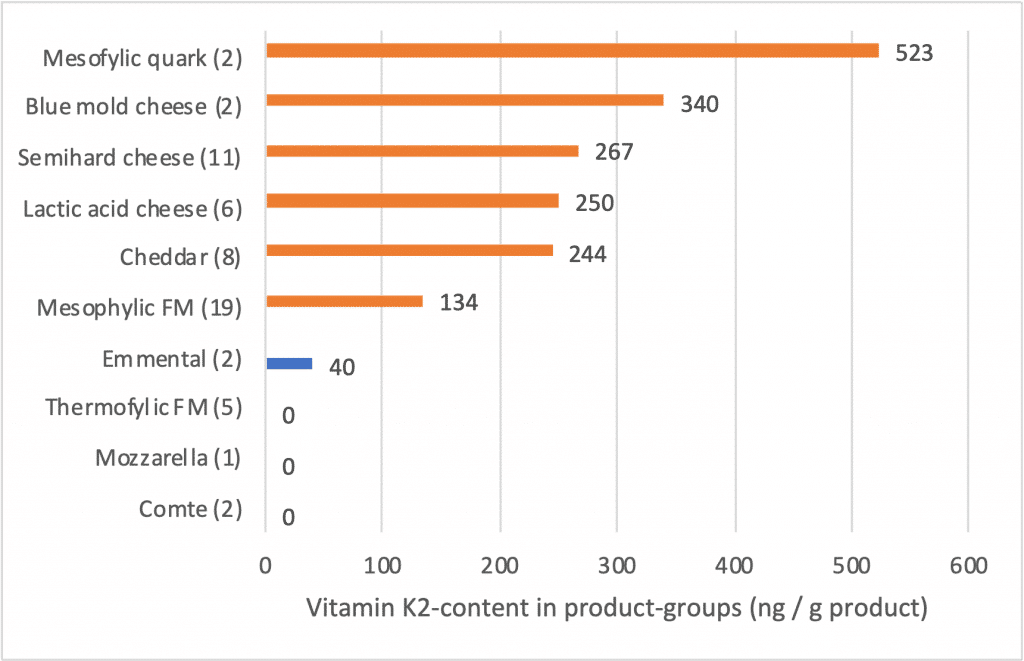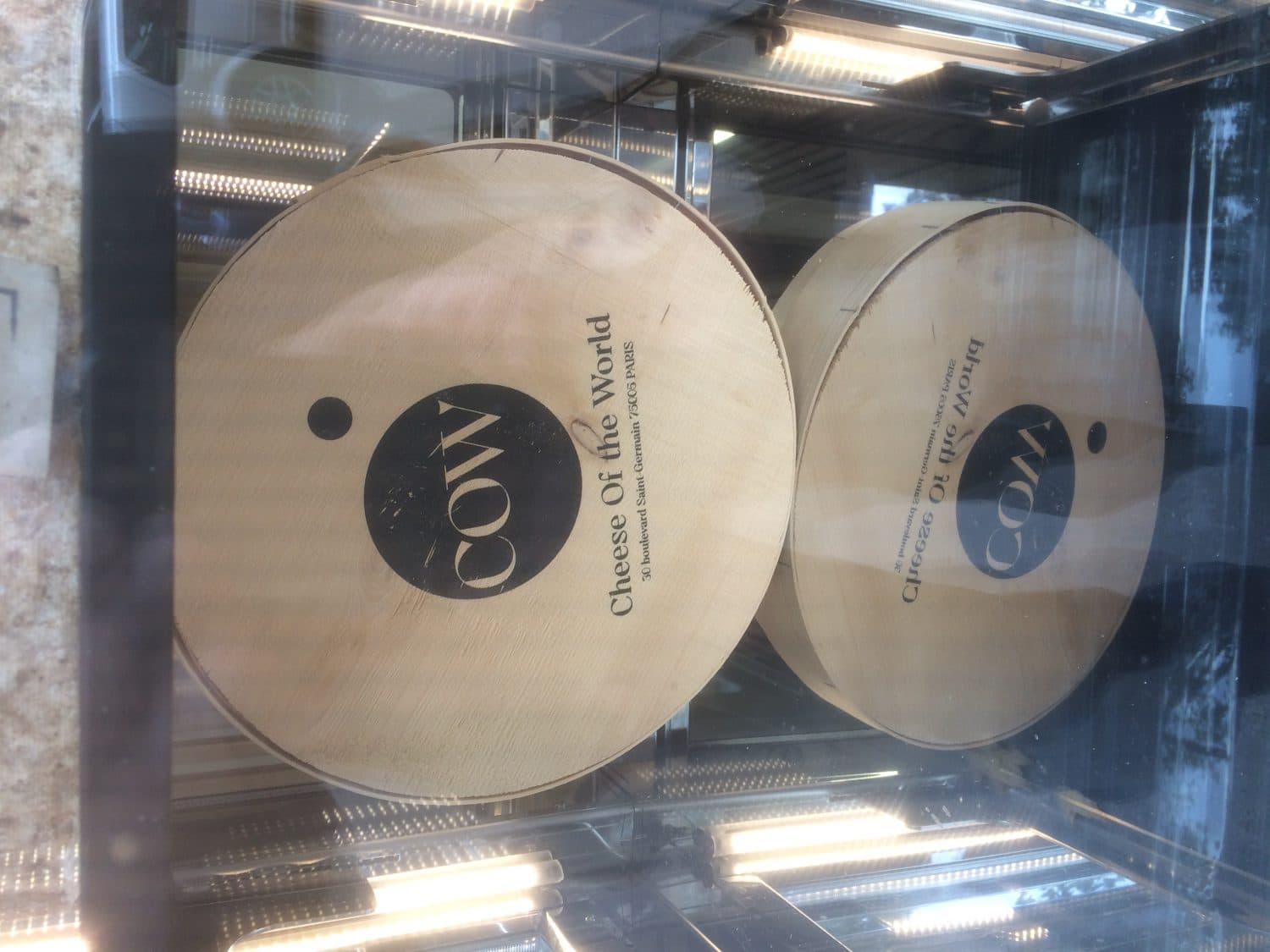Take home message
- The biggest difference in Vitamin K2 content between fermented milk products is due to the use of thermophyle or mesophyle cultures. Thermophyle bacterial cultures produce little or no K2.
- Certain bacteria, such as Leuconostoc, produce a lot of K2.
Types of Menaquinone (MK)
In 2013, French researchers (Manoury et al., 2013) investigated the different forms of vitamin K2 (Menaquinone) in 62 types of fermented milk products, originating from different European countries and belonging to different cheese families (product groups). Their research provided a number of new insights into the factors that determine the K2 levels in the products.
Vitamin K2 is found in the main forms: MK6, MK7, MK8, MK9 and MK10. The different forms are related to small changes in the basic skeleton of Menaquinone. The Vitamin K2 content of the dairy product (nanograms / g product) is the sum of all forms. K2 content of a product is partly determined by the fat content, and starter culture composition. A starter culture consists of different types of microorganisms and these can contain mesophylic or thermophylic bacteria. Traditionally, the use of mesophilic cultures were used more in the cooler European countries, whereas the thermophylic cultures were used more in the Central and Southern parts of Europe. Mesophylic bacteria grow optimally at 20-30 oC, while the thermophylic bacteria prefer a warmer environment (35-50 oC). In the semi-hard cheeses such as Dutch (Gouda, Edam) and English cheese cultures (Cheddar) production the maximum temperature is around 37 oC and therefore mesophylic cultures are used. The really large wheel, hard cheeses such as Emmentaler, Comte, Mountain cheese and Parmesan use much higher temperatures during the processing, thus these cheeses use thermophylic starter cultures. In German, this is referred to as a “Brennprozess”, where the copper kettle was originally put above a wood fire to reach a temperature of 54-56 oC.
In another cheese family, the lactic acid cheeses, processing is based on the starter culture rather than on renneting; among others the white and blue mold cheeses (Brie, Camembert, Roquefort). Like the Gouda processing, these fresh cheeses are made at low temperatures, with a high moisture content, a low pH and the ripening takes place using fungi. There are also all kinds of fermented drinkable milk products (FM). These can be made on using either mesophyle or thermophyle starter. Kefir and the Nordic ‘fil’ products are made with mesophylic bacteria at room temperature (20- 24 oC) and these takes around 20 hours to ferment. Yogurt is made using thermophylic cultures at 40-45 oC. Due to the higher temperature, yoghurt is fermented in a shorter period of time (6-8 hours).
Bacteria, genera and species
During fermentation, milk sugar (lactose) is converted into lactic acid associated with a decrease in pH (increasing acidity). This conversion takes place by various lactic acid-forming bacteria, for example the genus Lactococcus, Lactobacillus, Streptococcus, Bifidobacterium or Leuconostoc. Thermophyle starter cultures also contain Streptococcus thermophilus, Lactobacillus delbrueckii, and Bifidobacterium. Propionobacterium is used in the thermophyle starter such as in Emmentaler cheese. This bacterium gives the cheese large, round eyes and a slightly sweet taste.
Vitamin K2 in dairy products
The overview of vitamin K2 contents in 98 types of cheese and fermented milk products emanates from three studies. The products were divided into 11 product groups based on origin and designation. The average total vitamin K2 content of the products are shown per product group in figure 1.

Fig. 1. Vitamin K2 content in different fermented product groups (the number of samples in brackets). Two clear groups can be distinguished based on the mesophyle (blue bars) and thermophyle (orange bars) cultures that were used in production.
(FM = fermented milk)
The milk products based on a thermophylic culture include the cheeses Comte, Emmentaler and Mozzarella. The thermophylic fermented drinking milk products (Yoghurt) do not contain K2. All products made with mesophylic cultures are all (very) rich in K2. Here you will also find all semi-hard Dutch cheeses (Gouda, Edam, Milner), and other cheeses using similar recipes. Mesophylic cultures are also used with the soft cheeses (fresh cheese, white mold and blue mold) and the fermented drink products made with mesophylic cultures. Quark scores very high in K2, in which a Leuconostoc bacterium is used (Polish; tvarog = quark). Fresh cheeses that ripen on the basis of a white mold (Brie, Camenbert) or a blue mold (Roquefort, Stilton) usually have high contents of K2.
MK6 to MK10
It is known that the thermophylic bacteria produce (almost) no Vitamin K2, or only produce MK-10. The mesophylic products, such as cheddar cheeses and the semi-hard cheeses, consist of 67% MK9 and 18% MK8. There are of course differences per product group and product. The thermophylic products contain little or no Vit K2, with the exception of Emmental cheese, which, consists of 100% MK10. None of the other MK forms (MK6 to MK9) have been found in the thermophylic products. The highest levels have been seen in a French white mold cheese (almost 1,200 ng/g) and an English blue cheese (over 700 ng/g). However, another blue cheese from France had much lower levels (only 50 ng/g). These results indicate that there are additional influences, perhaps by specific cultures.
Data from this article is from:
Manoury, E., Jourdon, K., Boyaval, P., & Fourcassié, P. (2013). Quantitative measurement of vitamin K2 (menaquinones) in various fermented dairy products using a reliable high-performance liquid chromatography method. Journal of dairy science, 96(3), 1335-1346.
Chollet, M., Guggisberg, D., Portmann, R., Risse, M. C., & Walther, B. (2017). Determination of menaquinone production by Lactococcus spp. and propionibacteria in cheese. International Dairy Journal, 75, 1-9.
Vermeer, C., Raes, J., Van’t Hoofd, C., Knapen, M. H., & Xanthoulea, S. (2018). Menaquinone content of cheese. Nutrients, 10(4), 446.




